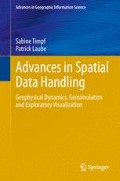Abstract
This work describes a mathematical representation of terrain data consisting of a novel operation, the “drill”. It facilitates the representation of legal terrains, capturing the richness of the physics of the terrain’s generation by digging channels in the surface. Given our current reliance on digital map data, hand-held devices, and GPS navigation systems, the accuracy and compactness of terrain data representations are becoming increasingly important. Representing a terrain as a series of operations that can procedurally regenerate the terrains allows for compact representation that retains more information than height fields, TINs, and other popular representations. Our model relies on the hydrography information extracted from the terrain, and so drainage information is retained during encoding. To determine the shape of the drill along each channel in the channel network, a cross section of the channel is extracted, and a quadratic polynomial is fit to it. We extract the drill representation from a mountainous dataset, using a series of parameters (including size and area of influence of the drill, as well as the density of the hydrography data), and present the accuracy calculated using a series of metrics. We demonstrate that the drill operator provides a viable and accurate terrain representation that captures both the terrain shape and the richness of its generation.
Access this chapter
Tax calculation will be finalised at checkout
Purchases are for personal use only
References
Abdelguerfi M, Wynne C, Cooper E, Roy L (1998) Representation of 3-d elevation in terrain databases using hierarchical triangulated irregular networks: a comparative analysis. Int J Geogr Inf Sci 12(8):853–873. http://www.tandfonline.com/doi/abs/10.1080/136588198241536
Agarwala A (1999) Volumetric surface sculpting. Ph.D. thesis, Massachusetts Institute of Technology
Bartholdi JJ, Goldsman P (2004) Multiresolution indexing of triangulated irregular networks. IEEE Trans Visual Comput Graphics 10(4): 484–495
Benes B, Forsbach R (2001) Layered data representation for visual simulation of terrain erosion. In: Proceedings of the 17th spring conference on computer graphics, Washington
De Floriani L, Puppo E (1995) Hierarchical triangulation for multiresolution surface description. ACM Trans Graph 14:363–411
Farin G (2002) Curves and surfaces for CAGD: a practical guide, 5th edn. Morgan Kaufmann Publishers, San Francisco
Faux ID, Pratt MJ (1979) Computational geometry for design and manufacture. Halsted Press, New York
Franklin WR, Inanc M, Xie Z (2006) Two novel surface representation techniques. In: Autocarto 2006. Cartography and geographic information society, Vancouver, Washington, (25–28 June 2006)
Freeman H (1974) Computer processing of line-drawing images. ACM Comput Surv 6(1): 57–97. http://doi.acm.org/10.1145/356625.356627
Gao J (1997) Resolution and accuracy of terrain representation by grid dems at a micro-scale. Int J Geogr Inf Sci 11(2):199–212
Inanc M (2008) Compressing terrain elevation datasets. Ph.D. thesis, Rensselaer Polytechnic Institute
Metz M, Mitasova H, Harmon RS (2011) Efficient extraction of drainage networks from massive, radar-based elevation models with least cost path search. Hydrol Earth Syst Sci 15(2):667–678
O’Callaghan JF, Mark DM (1984) The extraction of drainage networks from digital elevation data. Comput Vis Graphics Image Process 28:323–344
Ramer U (1972) An iterative procedure for the polygonal approximation of plane curves. Comput Graphics Image Process 1(3):244–256http://dx.doi.org/10.1016/S0146-664X(72)80017-0
Stuetzle C, Cutler B, Chen Z, Franklin WR, Kamalzare M, Zimmie T (2011) Ph.d. showcase: measuring terrain distances through extracted channel networks. In: 19th ACM SIGSPATIAL International conference on advances in geographic information systems, Chicago, 2011
Velho L, de Figueiredo LH, Gomes J (1999) Hierarchical generalized triangle strips. Vis Comput 15:21–35. doi: 10.1007/s003710050160
Acknowledgments
This research was partially supported by NSF grants CMMI-0835762 and IIS-1117277. We would like to thank the reviewers for their helpful comments.
Author information
Authors and Affiliations
Corresponding author
Editor information
Editors and Affiliations
Rights and permissions
Copyright information
© 2013 Springer-Verlag Berlin Heidelberg
About this chapter
Cite this chapter
Stuetzle, C., Franklin, W.R. (2013). Representing Terrain with Mathematical Operators. In: Timpf, S., Laube, P. (eds) Advances in Spatial Data Handling. Advances in Geographic Information Science. Springer, Berlin, Heidelberg. https://doi.org/10.1007/978-3-642-32316-4_10
Download citation
DOI: https://doi.org/10.1007/978-3-642-32316-4_10
Published:
Publisher Name: Springer, Berlin, Heidelberg
Print ISBN: 978-3-642-32315-7
Online ISBN: 978-3-642-32316-4
eBook Packages: Earth and Environmental ScienceEarth and Environmental Science (R0)

